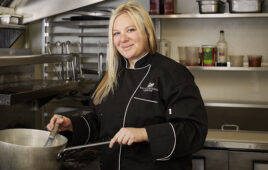According to Colby Newman, Executive Chef of Amarillo (Texas) Country Club, wine pairings should give members and guests the best experience of collective flavors.
When it comes to dining at Amarillo (Texas) Country Club, wine dinners are one of the most important experiences we can offer—for our members, for my staff and for myself, too.
Once or twice a month we host a dedicated wine dinner either with a specific winery or as part of a Chef’s table. In both cases, it’s not just about showcasing the wine or the food, but rather to highlight the relationship and dynamic between the two.
At its simplest, cooking is about balancing fat, acid, salt and sweet. But when you do a pairing, you must also consider the way these elements interact with bitter or tannic notes as well as the alcohol itself. In order to do both the food and the wine justice—which is always the goal—I must first understand everything I can about the wine. From there, I must create pairings that marry well, whether that means balancing acid + acid, sweet + salty, bitter + fat, acid + fat or alcohol + fat or something else entirely.
And even though I have hundreds of ideas for dishes scribbled in Moleskin notebooks (which, by the way, go with me everywhere I go just in case a spontaneous idea strikes), I can’t randomly pick several and just expect them to work. The food components might be good together, but once you add the wine it could change the dish completely.
So for me, it starts with understanding the wine. Then building the dishes from there.
It’s important to note that the dishes we feature during these events are drastically different than the ones on our daily menus. In order to appeal to our members on a day-to-day basis, we offer a range of items that aren’t overly intimidating or complicated. Our members gravitate toward simple, comfort foods. Wine dinners, on the other hand, offer our members a different type dining experience—one that pushes the culinary envelope and features more complex components and ingredients.
These events serve double duty as they help my cooks and I decide which ingredients could work for seasonal menu changes and even specials. They allow us to push our members out of their comfort zones, especially since they don’t find out the menu until that evening. With both the food and the wine, our members discover ingredients and combinations they never thought they would like or would ever think to try, along with the importance of the relationship between food and wine.
These events are also a great opportunity for our members to interact with one another. They support the purpose of our club and add value as the members form friendships and make memories over an incredible meal.
At the end of each dinner, members have the opportunity to purchase any of the featured wines either for their wine lockers or their homes. They can also report back to me on which wines they’d like us to add to our ever-evolving wine list.
Our wine dinners, which allow up to 35 members, start with an amuse bouche, followed by four courses, including dessert. They are what I consider to be a non-traditional style dinner, meaning there isn’t a soup, salad, entrée, and dessert. Instead, I base my courses on pairings so the only thing guaranteed is that dessert will be last.
Our most recent wine dinner was with Barons Winery from Washington state. We featured five of their most popular wines—Sauvignon Blanc, Colombia Valley Cabernet Sauvignon, Colombia Valley Petit Baron, and Red Mountain Cabernet Sauvignon—and the winery’s brand manager came to discuss the wines between each course. (Check out the menu here and view the recipe for our Chicken Fried Short Rib with Summer Fruit Panzanella and Romesco.)
I also like to think outside the box when it comes to choosing ingredients and flavor combinations for these menus. They give my team a chance to better understand my menu development thought process and discover ingredients and flavors, while learning new styles and techniques.
When you’re the Executive Chef of a country club, you don’t always get to cook. Many of your days are spent in meetings, doing paperwork, creating new menus, researching, expediting, and managing your staff. Being an Executive Chef means many more responsibilities, which sometimes means fewer opportunities to cook. So wine dinners are something I always look forward to because I get to actually cook and tap into that creative outlet that got me to where I am today. These events remind me why I love to do what I do and they push me to constantly learn and evolve.
After a wine dinner, I always end the night asking my wife to remind me to never stop cooking, especially when I’m burnt out, stressed or overwhelmed. As club chefs, we have a unique opportunity many other chefs don’t get. Yes, we have to make daily menus that don’t always push the envelope. But we also get to make meals like these using ingredients and techniques that are inspiring and unique.





